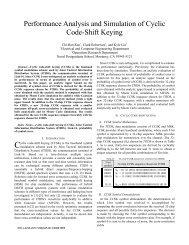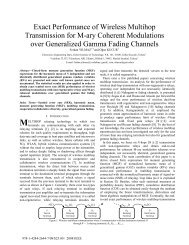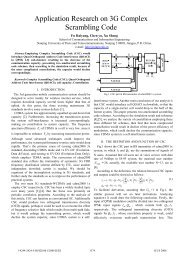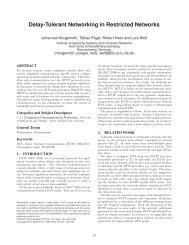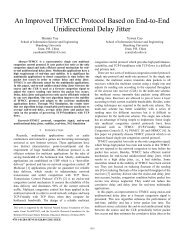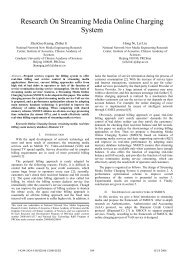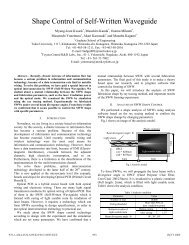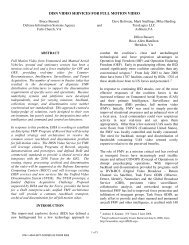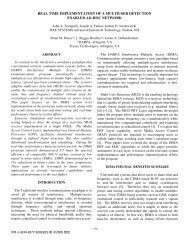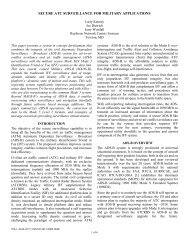Practical Implementation of PN Scrambler for PAPR Reduction
Practical Implementation of PN Scrambler for PAPR Reduction
Practical Implementation of PN Scrambler for PAPR Reduction
Create successful ePaper yourself
Turn your PDF publications into a flip-book with our unique Google optimized e-Paper software.
The probability that the power W > L occurs at least m=1<br />
time out <strong>of</strong> N samples is<br />
Pr{A occurs at least 1 time in N samples} =<br />
N ⎛ N ⎞ i N −i<br />
∑= ⎜ ⎟ ⋅ p q<br />
i 1 ⎝ i ⎠<br />
(19)<br />
In order to simplify the equation, note that the probability<br />
W > L occurs at least m=1 time out <strong>of</strong> N samples is the<br />
same as the complementary probability that exactly no<br />
samples (m=0) have W > L, which can be written as<br />
1-Pr{A occurs exactly 0 times out <strong>of</strong> N samples} =<br />
⎛ N ⎞ N<br />
N<br />
N<br />
1−<br />
g N ( 0)<br />
= 1−<br />
⎜ ⎟ ⋅ p q = 1−<br />
q = 1−<br />
( 1−<br />
p)<br />
= 1−<br />
F<br />
⎝ 0 ⎠<br />
0 N<br />
W ( L)<br />
(20)<br />
Thus, we now define the CCDF <strong>of</strong> the peak power per<br />
OFDM symbol as the probability that the peak power <strong>of</strong><br />
one sample out <strong>of</strong> N samples exceeds threshold L<br />
N<br />
⎛ ⎛ L ⎞⎞<br />
Fsym = Pr{<br />
PeakPowerOFDM<br />
_ Symbol > L}<br />
= 1−<br />
⎜1<br />
− exp⎜<br />
− ⎟⎟<br />
2<br />
⎝ ⎝ 2 ⋅σ<br />
⎠⎠<br />
(21)<br />
Using the <strong>PN</strong> scrambler to generate k OFDM symbols and<br />
then selecting the OFDM symbol with the lowest <strong>PAPR</strong><br />
<strong>for</strong> transmission reduces the peak power probability to p k .<br />
For example, if an OFDM symbol has the probability <strong>of</strong><br />
p=0.1 <strong>of</strong> exceeding threshold L, then the probability <strong>of</strong> k=2<br />
OFDM symbols exceeding threshold L is (0.1) 2 =0.01.<br />
This is true because <strong>of</strong> the statistical independence <strong>of</strong> the<br />
peak power between OFDM symbols generated by the <strong>PN</strong>-<br />
<strong>Scrambler</strong> (i.e. uncorrelated data sets). That is, if the<br />
probability <strong>of</strong> event S1 does not depend upon the outcome<br />
<strong>of</strong> S2 and visa versa, such events are said to be statistically<br />
independent and<br />
Pr(S , S )<br />
=<br />
1<br />
2<br />
2<br />
= Pr(S1)<br />
⋅ Pr(S2)<br />
= p ⋅ p p (22)<br />
For k statistically independent events, this becomes<br />
Pr(S , S ,..., S )<br />
=<br />
1<br />
2<br />
k<br />
k<br />
= Pr(S1)<br />
⋅Pr(S2<br />
) ⋅⋅⋅<br />
Pr(Sk<br />
) = p⋅<br />
p⋅<br />
⋅⋅<br />
p p (23)<br />
For k scrambling sequences, the new <strong>PAPR</strong> CCDF per<br />
OFDM symbol can now be <strong>for</strong>mally written as<br />
Pr<br />
{ <strong>PAPR</strong> k > L}<br />
OFDM _ Symbol sequences<br />
N<br />
⎛<br />
⎞<br />
⎜ ⎛ ⎛ L ⎞⎞<br />
= 1−<br />
⎜1−<br />
exp⎜<br />
− ⎟⎟<br />
⎟<br />
⎜<br />
2<br />
2 ⎟<br />
⎝ ⎝ ⎝ ⋅σ<br />
⎠⎠<br />
⎠<br />
k<br />
2 1<br />
σ =<br />
2<br />
(24)<br />
Substituting equation (13) into (21) yields<br />
F = 1 − F<br />
N<br />
(25)<br />
sym<br />
W<br />
4 <strong>of</strong> 7<br />
Rearranging, the sample-based power distribution is<br />
related to the OFDM symbol-based peak power<br />
distribution by<br />
( ) N<br />
1<br />
FW<br />
= 1− F<br />
(26)<br />
sym<br />
Next, we define the new <strong>PAPR</strong> distribution Fsym ˆ as the<br />
OFDM symbol-based peak-power distribution after k<br />
scrambling sequences<br />
k<br />
N k<br />
F ˆ<br />
sym = Fsym<br />
= ( 1 − FW<br />
)<br />
(27)<br />
Finally, in order to determine FW ˆ , which is the new <strong>PAPR</strong><br />
reduced sample-based power distribution after application<br />
<strong>of</strong> k scrambling sequences, we simply substitute Fsym ˆ into<br />
equation (26) relating the sample-based power distribution<br />
to the OFDM symbol-based peak power distribution,<br />
Fˆ<br />
W<br />
=<br />
1<br />
N<br />
N k<br />
( 1 − Fˆ<br />
) = ( 1 − ( 1 − F ) )<br />
sym<br />
W<br />
1<br />
N<br />
1<br />
N<br />
k N<br />
⎛<br />
⎞<br />
⎜ ⎛<br />
L ⎞<br />
1 ⎜ ⎛ ⎛ ⎞⎞<br />
⎟<br />
= ⎜ − 1 − ⎜1<br />
− exp⎜<br />
− ⎟ ⎟<br />
2 ⎟<br />
2<br />
⎟<br />
⎜ ⎜<br />
⎟ ⎟<br />
⎝ ⎝ ⎝ ⎝ ⋅σ<br />
⎠⎠<br />
⎠ ⎠<br />
(28)<br />
In the above equation, FW ˆ is the CDF <strong>of</strong> the <strong>PAPR</strong><br />
reduced sample-based distribution using k-scrambling<br />
sequences, which is the probability that each individual<br />
sample’s peak power is less than or equal to threshold<br />
level L using an IFFT size <strong>of</strong> N. It is more useful to<br />
evaluate the probability that each individual sample’s peak<br />
power is greater than threshold level L, which is the<br />
complementary CDF, CCDF=1-CDF.<br />
1<br />
k<br />
N<br />
N<br />
⎛<br />
⎞<br />
⎜ ⎛<br />
L ⎞<br />
CCDF(<br />
L,<br />
N,<br />
k)<br />
1 1 ⎜ ⎛ ⎛ ⎞⎞<br />
⎟<br />
= − ⎜ − 1−<br />
⎜1−<br />
exp⎜<br />
− ⎟ ⎟<br />
2 ⎟<br />
2<br />
⎟<br />
⎜ ⎜<br />
⎟ ⎟<br />
⎝ ⎝ ⎝ ⎝ ⋅σ<br />
⎠⎠<br />
⎠ ⎠<br />
(29)<br />
After normalization <strong>of</strong> the complex time-domain signal’s<br />
average power<br />
<strong>PAPR</strong><br />
CCDF<br />
1<br />
N k N<br />
= 1−<br />
⎜<br />
⎛1− ( 1−<br />
( 1−<br />
exp(<br />
− L)<br />
) ) ⎞ (30)<br />
( L,<br />
N,<br />
k)<br />
⎟<br />
⎝<br />
⎠<br />
It is important to note that due to the equivalence<br />
theorem, the analysis and linear signal processing <strong>of</strong><br />
baseband wave<strong>for</strong>m presented herein will be identical to<br />
the analysis <strong>of</strong> the bandpass wave<strong>for</strong>m with the exception<br />
<strong>of</strong> oversampling error. A rigorous discussion <strong>of</strong> the <strong>PAPR</strong><br />
measurement error due to Nyquist sampling versus<br />
continuous sampling can be found in [10]. Because most<br />
applications are typically concerned with the probability<br />
that a signal’s power exceeds a certain level L, instead <strong>of</strong><br />
using the CDF, the CCDF is typically plotted and is shown<br />
in Fig. 3 <strong>for</strong> FFT sizes N=64, N=128, N=256 and number<br />
<strong>of</strong> scrambling sequences k=1 (i.e. no <strong>PAPR</strong> reduction),<br />
k=8, and k=256. The plot shows both the theoretical<br />
curves obtained using equation (30) and the empirical<br />
curves obtained through computer simulations.



